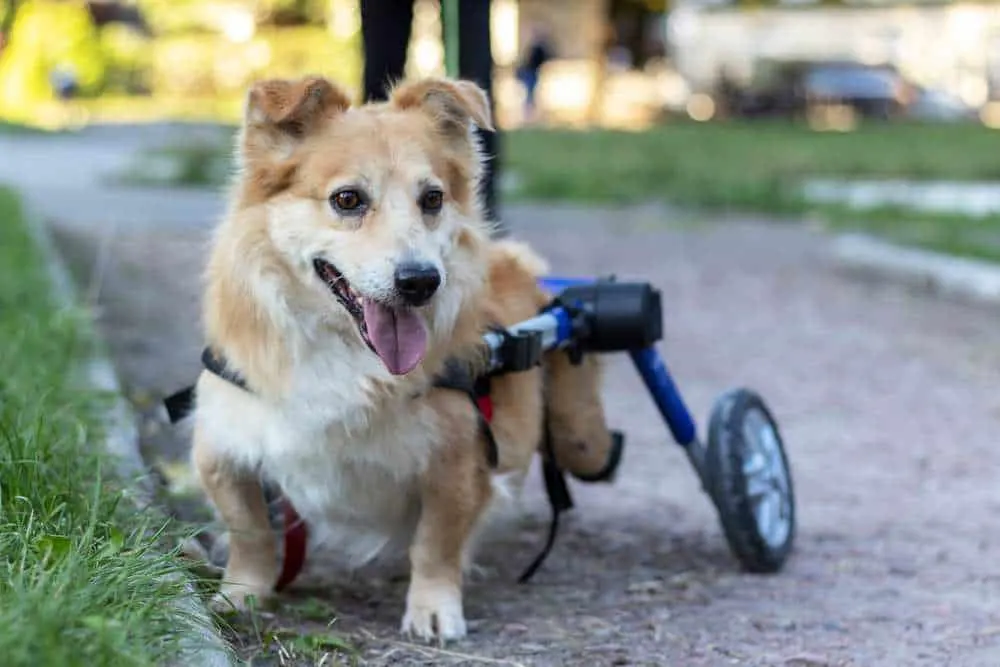Bringing a dog into the family is a big decision. With that decision come many questions. What kind of breed do you want? Can you handle owning a dog from a financial standpoint?
And these are all important questions that you need to really think about before your ultimate decision. But one thing that not enough people do is research. Not just research about what it’s like owning a puppy, but the more serious kind.
Every breed comes with its good and bad sides. There are many health risks that your puppy could encounter over its lifetime. Some could happen by pure chance, while others, unfortunately, get carried in your puppy’s genes.
Corgis are not famous for being prone to many health risks. And hoping that your puppy will have a healthy life is fine, but being prepared for problems is necessary. One of the possible conditions that you need to worry about is Degenerative Myelopathy (DM).
In short, DM is a progressive, incurable condition that affects the spinal cord’s nerves and causes a gradual loss of mobility and feeling in the limbs. Breeds that are commonly affected are German Shepherds, Welsh Corgis, Irish Setters, and Chesapeake Bay Retrievers. The only thing that is positive in this whole scenario is that it is a painless disease.
If you plan on getting a Corgi or have a Corgi that may be suffering from the disease – stick with us for a while. We did some research, so you don’t have to. This is a terrible disease that could affect a part of your family, so informing yourself as much as you can is essential. So, Degenerative Myelopathy (DM) In Corgis – what is it, and how can you deal with it?

What Is Degenerative Myelopathy?
Degenerative Myelopathy is a disease of the nerves that causes your dog to lose control of its limbs. It is a terrible condition that has, we suppose, one silver lining. However awful it might be, it is painless. Because the nerves control pain in your dog’s body when they cannot work, it means that the pain receptors don’t work either.
We know that that’s far from saving grace, but it helps a little to know that there’s no pain involved. So how does this happen? What does it mean to be prone to a particular disease?

How Your Puppy Gets DM?
Being prone to a particular disease means that you carry it in your genes. Dogs are no different; they have a vast amount of information in their genes. Sometimes that information is one that makes their system go haywire.
Basically, that’s what these diseases are. The genes tell the body to do something, and they don’t know if it’s good or bad. They tell your Corgi to grow out a thick and heavy coat to get prepared for winter.
Similarly, they give out the command for the body to grow to a specific size, etc. Genes transferring diseases just means that the information does more harm than good. All life is based on genetic mutations. Unfortunately, they’re not always perfect.
Your Corgi has a 50% chance of getting the disease from its parent. It has a 30% chance of just being the carrier. So if we do some math here, we’ll see how it works. In a family of Corgis, each member has a 50/50% chance of getting DM, while they have a 30% chance of giving it to their children.
With that said, we don’t know what causes DM in dogs. The condition is transmitted through the genes, but that’s pretty much all we know so far. One interesting thing is that the genetic marker that seems to cause DM in dogs is the same marker that causes ALS in humans. The obvious similarities in the diseases are cause for much research.

How Common Is DM In Corgis?
Unfortunately, Corgis are on the list of dogs who commonly get DM. German Shepards, Irish Setters, and Chesapeake Bay Retrievers are also on the list.
There is still no knowledge as to why these breeds get affected. This doesn’t mean that other breeds can’t get affected.

At What Age Does It Start?
Typically, DM symptoms start at around the age of 8 to 12 years old. This number can vary from breed to breed, so it’s not something to go by exactly. Some cases are reported to start at the age of 14.
Once it starts, the symptoms develop for 6 to 12 months, and the result is unfortunately always fatal. The age at which it starts can be different for each dog, but these are the general numbers. Knowing what to expect helps you prepare, but knowing when it could happen is just as important.
The thing is that Corgis don’t change much as they age; they tend to be as energetic at age ten as they were at age 6. This makes noticing early symptoms easier than with other dogs.

Degenerative Myelopathy In Corgis
So what does it mean for a Corgi to get DM? Is it hard for them? Well, we said that this is, fortunately, a painless disease. But that doesn’t mean that it is not frustrating for the affected dogs.
As we said, Corgis are still quite energetic and active at the age of 10. Losing the ability to move as well as before is usually very frustrating for your pup.
Degenerative Myelopathy symptoms can start anywhere from the age of 10 and onward. Your Corgi can have the DNA marker and never actually show signs of the disease. If the symptoms start showing themselves at a very old age, there’s a chance that your dog won’t live long enough to develop the disease completely.
When at such an old age, your dog’s health is generally not what it once was. Even the beginning of this aggressive condition can be enough for your dog’s body to give up. This is why there are many cases in which the owners never actually find out that the Corgi had DM. The only real and concrete method of finding out if a dog has DM is to do an autopsy and check the spinal cord under a microscope.
The symptoms take about 6-12 months to develop. If your dog is in his 15th year, the chances are that you’ll never actually notice that there’s something wrong.

What Are The Signs Of DM In Corgis?
The most common first signs of Degenerative Myelopathy in corgis are:
- Losing feeling and sensation in the back legs
- Losing control of bladder and bowel movement
- Difficulty walking or standing up
- Eventual loss of feeling in the front legs
So if the dog is already not the healthiest when the disease kicks in, what’s to say that it won’t be mistaken for something else?
This is a big concern for a lot of people. If you’ve done your research, you know that this could be a nightmare for you and your family. Corgis tend to live for a long time, and in this time, they truly become a part of the family. Let’s take a look at what other conditions certain DM symptoms could be pointing to.
Slipped Disks
Any condition that affects the spinal cord can have the same symptoms as DM. Herniated intervertebral disks (a.k.a. Slipped disks) is one of those conditions.
The intervertebral disk absorbs the shock between the spine and the legs. Unfortunately, when it comes to short-legged dogs, like the Corgi, there are many cases of those disks getting herniated. When this happens, the disks are no longer shock absorbers,, but they pressure the spinal cord.
This results in the same symptoms that DM would give your dog. The legs get weaker as time goes on, and there’s a possibility of paralysis. The main difference between slipped disks and DM is that the latter is almost always fatal. Slipped Disks can be fixed completely through surgery if they’re caught on time.
Other Spinal Cord Conditions
Many diseases can have to inflict the same symptoms on your dog. All of them have to do in some way with the spinal cord. Usually, these are infections, tumors, physical injuries, or strokes.
Whenever something happens to the spinal cord, the nervous system suffers the consequences. When this happenes, movement gets limited, and sensations fade.

What Does DM Testing In Corgis Look Like?
There is no actual way to test for DM. Your vet can give the diagnosis through the process of elimination. The only real way to know is to check the actual spinal cord, which they can only do during an autopsy. The surgery necessary to just check the spinal cord is far too dangerous and not at all worth the risk.

What To Do If Your Corgi Has Been Diagnosed
While many researchers have tried to find a way to treat this disease, none have yet been successful. At the time of writing this article, there is no way of stopping or even slowing down Degenerative Myelopathy. There are, however, ways of making it a bit easier on your dog.
Here are a couple of things that you can do at the beginning and throughout the course of the disease. It’s important to remember that your Corgi doesn’t understand what’s happening. This means that it will, if faced with this situation, get very frustrated at times.
It is on you to keep moving forward and try and be as positive as you can be. Your dog feeds on your emotion, so if you’re frustrated, it will make the situation even more difficult for your dog.

Best Sleeping Arrangement
Your Corgi needs to sleep in the ideal position that doesn’t affect it negatively. Not many people realize the damage that a wrong sleeping position can cause to a dog suffering from Degenerative Myelopathy.
The suggestions that we plan to give depend on the specific condition of your dog. There are a couple of factors on which this depends. The first and main one that we have to mention is how much the disease has progressed in your dog.
We already talked about how DM symptoms progress with time. As the condition gets worse, so does the paralysis. And with that, you need to know how to set up your Corgis sleeping arrangement.
Your dog will want to sleep on hard and cold surfaces. This is not a symptom of the disease; it’s just generally a dog’s preference. The problem with this is that there is a risk of it getting pressure sores on hard surfaces. Not only that, even if your dog’s sleeping on a semi-hard surface, you need to make sure to flip him every once in a while.
Some beds and surfaces are designed specifically for this kind of condition. The bigger, the better. If the DM is at its early stages, your pup will still be able to move its front legs. What you don’t want to do is to let him/her drag all over the floor and get hurt by doing it.

Proper Care Of The Bladder
Your dog’s bladder is one of the first things that it will lose control over while suffering from DM. Because of this, it’s very important to know how to help it so you can avoid a possible Urinary Tract Infection (UTI).
The procedure of emptying your dog’s bladder is something you have to be taught by a professional. Now, we are aware that if your dog is suffering from DM, the chances are that you already visit your vet regularly. But some people feel confident in doing things by themselves.
This is not a good idea. This procedure is not complicated or hard to do, but you must know what you’re doing. Here are some symptoms of a UTI:
- Drops of urine around the house and in the bed
- Foul urine odor
- Discolored or bloody urine
- Depression, loss of appetite

Regular Bathing
Because of the bladder situation, there’s a good chance that your puppy will need a bath every once in a while. Just be careful not to do it too often. It’s also important to mention that you don’t have to use shampoo every time. Warm water and clean cloth will do.
The most important part that needs to stay clean is the paralyzed part. All you have to do is keep in mind that the cleaner your dog is, there’s less chance of it getting an extra infection added to this terrible situation.
As the condition worsens, your Corgi probably won’t be able to clean itself properly as much as it wants to. This is where it’s very important to make sure that you do the cleaning regularly, just to help him with the frustration.

Wheelchair
Wheelchairs are the most important part of this whole terrible ordeal. Possibly spotting DM and getting your dog accustomed to a wheelchair is crucial in this period.
Your Corgi will do whatever it can to move around. This means that it will rather drag itself all over the whole house than just stand still and accept defeat.
The problem with all this is that if it drags its body all over the floor, no matter what surface is under him – he’ll get surface sores. You must try your best to avoid these situations. You need to teach your dog that it can still move around, which is very important for a breed that is as active as the Corgi.
The frustration that comes with the disease will happen; all you can do is try and minimize it. But knowing that it mostly comes from not being able to follow people and other dogs around helps. Your dog always wants to be a part of the action, so he might get angry when that’s no longer an option.
This is why a wheelchair is crucial. Your dog will drag around as long as it’s able to. This will, as we already mentioned, bring nothing but injuries. Your vet will, without a doubt, tell you what to do and what kind to get. You should always rely on professional help in these situations.

How To Prevent DM In Corgis?
There is no known way to prevent DM development in Corgis or any other dog for that matter. This is because the disease is not something that happens because of outside factors; it is already in the dog’s genes at birth.
Preventing DM in Corgis is actually up to the breeders. They could have information about which dogs are carriers and which dogs are at risk of actually developing the disease. At-risk Corgis have shown to have puppies who will develop DM.
But even with that in mind, there’s no way of benign sure that the puppy isn’t at risk. All they can do is try and lower the chances.
Learn More: Genetic Diseases In Corgis

Final Words
Degenerative Myelopathy is a terrible disease. As we already said, there is usually nothing more to do than take care of your Corgi to the best of your abilities.
Many owners choose to put down their beloved dogs, so they don’t have to go through it all. This is a tough decision to make, but it is one of the options. Once your vet has done all the tests, MRI, CAT scans, and has eliminated other possibilities – they will present you with the option.
We suppose that the only good thing is that the symptoms don’t begin to manifest until age ten and onward.
Whatever you decide to do, just give your dog as much love as you can. Corgis can quickly become an integral part of our family, and we owe them a beautiful life no matter how and when it might end.
Learn More: Corgi Health Problems: Most Common Diseases In Corgis

